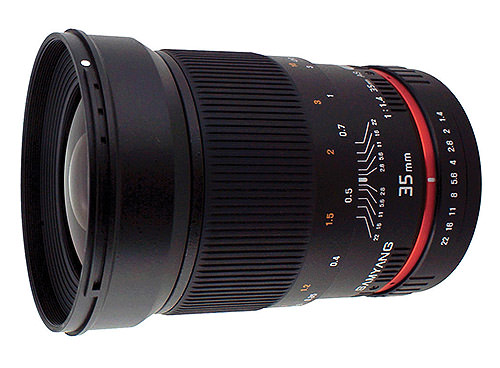This is an in-depth review of the Samyang 35mm f/1.4 AS UMC, a manual focus prime lens designed for Nikon, Canon, Sony, Olympus, Pentax, Samsung and Micro Four Thirds mounts. While I will be referring to this lens as “Samyang” in this review, please keep in mind that you can find exactly the same lens under different names such as Bower 35mm f/1.4 and Rokinon 35mm f/1.4 in the US. In fact, the South-Korean lens manufacturer Samyang Optics sells its lenses to different companies like Vivitar, Falcon, Rokinon, Walimex, Bower and Pro-Optic, which simply re-package the lens and imprint their logos / add tags and sell them. Interestingly, while the lens is exactly the same, these brands are sometimes sold at different price points too (probably due to differences in packaging). The lens I tested for this review is the “Samyang” version, supposedly branded and packaged by the original manufacturer.

The Samyang 35mm f/1.4 is targeted at photographers that do not need autofocus and want to get a fast aperture lens for a variety of needs such as landscape, architecture, street and travel photography. At just under $500, the lens is a huge bargain when compared to brand lenses from Nikon, Canon and Sony that all sell their pro-grade 35mm f/1.4 lenses at around the $1,500 price range. The Samyang 35mm f/1.4 is designed to work on both APS-C / DX and full-frame / FX sensors, so it will work on cameras like Nikon D7100 (with a similar field of view as a 52.5mm lens) and D800.

The Samyang brand is relatively new in the DSLR lens market. The brand became known after its 24mm and 85mm lenses that were released in 2011-2012 time frame received a lot of praise for their excellent sharpness and performance when compared to the Nikon and Canon versions. Since then, Samyang has been promoting its name in the photography world by releasing new bargain lenses for various camera mounts, including mirrorless. For example, the recently announced 16mm f/2.0 lens is specifically designed for APS-C and Micro Four Thirds mounts, targeting the fast-growing mirrorless market.
Is the Samyang 35mm f/1.4 really a bargain when compared to other 35mm lenses? How does it perform wide open and when stopped down? How does it handle? In this review, I will do my best to answer these and other questions and will show you samples from the lens, with comparisons against the Nikon 35mm f/1.4G, Sigma 35mm f/1.4 and Zeiss 35mm f/1.4 lenses.

Samyang 35mm f/1.4 Specifications
- Mount Type: Nikon, Canon, Sony, Olympus, Pentax, Samsung and Micro Four Thirds
- Focal Length: 35mm
- Maximum Aperture: f/1.4
- Minimum Aperture: f/22
- Lens Construction: 12 Elements in 10 Groups
- Angle of View: 63.1º
- Number of Diaphragm Blades: 8
- Minimum Focusing Distance: 30cm/11.8in
- Filter Size: 77mm
- Dimensions (Diameter x Length): 63x112mm
- Weight: 660g
Other technical information about the lens can be found in the Samyang 35mm f/1.4 AS UMC page from our lens database.

Lens Handling and Build
The Samyang 35mm f/1.4 AS USM does not have the same solid build as the Sigma 35mm f/1.4 or the impressively built all-metal Zeiss 35mm f/1.4 lenses. Its outer barrel is fully made of plastic and the only metal component seems to be the lens mount. While the outer shell is plastic, I am sure the lens has plenty of metal inside, since the lens is as heavy as its Nikon and Sigma counterparts. Keep in mind, that while metal construction is generally good for protection and wear, good plastic does not expand and shrink as much as metal does in extreme weather conditions. So there are certainly advantages and disadvantages to both.
As long as the focus/zoom rings are made of metal (and other inner components that physically move during AF or zoom operations), a plastic barrel can often be an advantage in cold weather, especially for handling it without gloves. I specifically pointed out focus/zoom and moving components, because if those are made of plastic, they have a tendency to get “sticky” in extremely cold temperatures and could potentially break if moved by force. I shot with the Samyang 35mm f/1.4 in near-freezing temperatures in February and it worked well without any problems when focusing. However, I do not know how well the lens would do at very cold temperatures way below zero.
While I did not have problems with cold temperatures, it does not mean that you can take this lens to tropics or expose it to rain and expect it to perform. The lens is definitely not weather sealed and it probably will start to act up if you use it in very wet conditions. In addition, the lens lacks a rubber gasket on the lens mount, which means that dust and other debris could potentially end up in your camera if you do not keep the lens mount clean.

The lens generally handles and balances well when attached to a camera. The focus ring was a little stiff at first, but got much better after several weeks of use. One huge advantage of this lens, in my opinion, is its large 77mm filter thread. When compared to other 35mm lenses in this review, this is the only lens in the group that features a 77mm filter thread. This means that you can use your standard polarizing, ND and other filters without having to worry about buying smaller filters or step-up rings. For me, this is certainly a huge convenience factor when working in the field.
Size-wise, the Samyang 35mm f/1.4 is a fairly tall lens. Take a look at the below image that shows its size relative to other 35mm lenses (From left to right: Sigma 35mm f/1.4, Nikon 35mm f/1.4, Zeiss 35mm f/1.4 and Samyang 35mm f/1.4):
As you can see, the barrel of the lens is pretty tall, with or without the petal type plastic hood. Note that being manual focus lenses, the Samyang 35mm f/1.4 and the Zeiss Distagon T* 35mm f/1.4 both have aperture rings. If you notice that your camera cannot recognize the lens, make sure that the aperture is set to the minimum aperture of f/22. Unfortunately, there is no aperture lock on this lens, so you might have to deal with this situation every once in a while.

Manual Focus Assist Accuracy
While the Samyang 35mm f/1.4 AS UMC is a manual focus lens, it still contains a focus chip on the lens that communicates with the focus system in your camera to assist in acquiring proper focus on your subject. When you look through the viewfinder, you will see that the camera will tell you which way to move focus to get proper focus using left and right arrows. When the camera thinks that focus is correct, it will show a circle instead of left/right arrows.
This communication with the lens means that while the lens does not autofocus, it still needs to be accurately calibrated for proper manual focus operation. Unfortunately, that’s where I often find issues with fast aperture manual focus lenses. Many lenses, including the Samyang 35mm f/1.4 are often improperly calibrated, which means that you could end up with out-of-focus pictures when trusting the camera’s manual focus assist feature. The Samyang 35mm f/1.4 that I had certainly had focus calibration problems, because I could not obtain any in-focus shots when using manual focus assist. The good news is, you can actually change and tune this behavior through the same “AF Fine Tune” feature of your camera that you use to tune lenses with autofocus capability. However, this feature is limited to +20 to -20 adjustments, which may not be enough if the lens sample is severely misaligned.

I highly recommend checking manual focus accuracy when you first receive your lens copy, so that you could exchange it for a different one, if needed. The procedure for checking focus accuracy is pretty straightforward – set your camera + lens on a tripod, fire up live view, zoom in to a close distance to your subject, then move the focus ring until the subject is in perfect focus. Next, turn off live-view and try to half-press your shutter button. If the focus indicator shows a green dot, then you are good to go. If you are seeing an arrow, use the AF Fine Tune feature to re-calibrate the lens and try again. If manual focus assist does not work beyond +20 or -20, your lens is very badly calibrated and needs to be returned or exchanged.
Table of Contents
